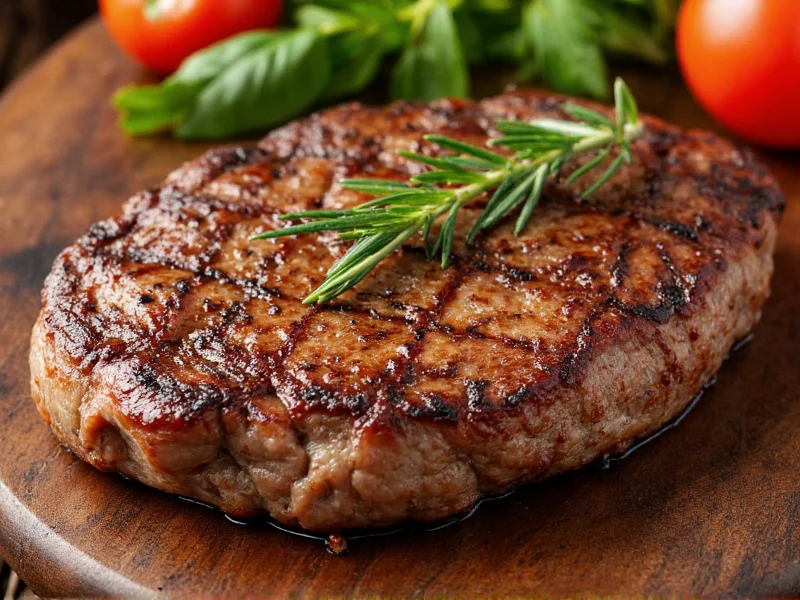Choosing between rosemary and thyme for steak isn't about which herb is superior—it's about understanding how each interacts with different cuts and cooking techniques. This guide breaks down the science and culinary principles behind these classic steak pairings to help you make informed decisions in your kitchen.
Understanding Herb Flavor Profiles
Rosemary and thyme belong to the same plant family (Lamiaceae) but offer distinctly different flavor experiences when paired with steak. Rosemary contains higher concentrations of camphor and eucalyptol, giving it that characteristic pine-like intensity that stands up remarkably well to beef's rich umami. Thyme, particularly common thyme (Thymus vulgaris), features thymol as its dominant compound, delivering earthier, more subtle notes with hints of mint and lemon.
The oil content in steak plays a crucial role in herb selection. Fatty cuts like ribeye or New York strip absorb and distribute rosemary's robust flavors throughout the cooking process, while leaner cuts like filet mignon benefit from thyme's gentler profile that won't overwhelm the delicate meat fibers.
Steak Cut Compatibility Guide
| Steak Cut | Best Herb Choice | Why It Works |
|---|---|---|
| Ribeye | Rosemary | Fat marbling carries rosemary's bold flavor throughout the steak |
| Filet Mignon | Thyme | Subtle flavor complements lean meat without overpowering |
| New York Strip | Rosemary | Balances the cut's robust beefiness with herbal intensity |
| Flank Steak | Thyme | Works well in marinades for this lean, textured cut |
| Porterhouse/T-bone | Both | Rosemary for strip side, thyme for tenderloin side |
Cooking Method Considerations
Your cooking technique significantly impacts which herb performs better. When grilling steak at high temperatures (450°F+), rosemary's hardy structure withstands direct flame better than thyme. The intense heat causes rosemary's essential oils to vaporize and infuse the meat with aromatic compounds. Try placing whole rosemary sprigs directly on hot coals for aromatic smoke infusion.
For sous vide or low-temperature cooking methods, thyme often proves superior. Its more delicate flavor compounds remain stable during extended cooking times without becoming bitter. When using thyme in sous vide preparations, combine it with garlic and black pepper in your vacuum-sealed bag for optimal flavor penetration.
Optimal Application Techniques
How you apply these herbs matters as much as which one you choose. For rosemary, always remove the tough woody stems before use—these won't soften during cooking and create unpleasant texture. Finely chop the tender needle sections or use them whole for infusion then remove before serving.
Thyme requires less preparation since the entire sprig remains tender when cooked. When making pan sauces after searing steak, add whole thyme sprigs to the deglazing liquid—they'll infuse the sauce while remaining easy to remove later. For maximum flavor extraction, bruise thyme leaves between your fingers before adding to marinades.
When to Combine Both Herbs
While choosing between rosemary or thyme for steak is common, professional chefs often combine both for complex flavor profiles. The classic French bouquet garni typically includes both herbs along with bay leaf. For steak preparations, use a 2:1 ratio of rosemary to thyme when combining—this balances intensity while creating depth.
Try this simple compound butter formula for grilled steak: soften ½ cup unsalted butter, mix with 1 tablespoon finely chopped rosemary, 2 teaspoons minced thyme, 2 minced garlic cloves, and a pinch of sea salt. Roll into a log, chill, then slice coins to melt over cooked steak. This technique works particularly well for dry-aged steaks where the herbs complement rather than compete with the concentrated beef flavor.
Avoiding Common Herb Mistakes
Many home cooks make critical errors when using rosemary or thyme with steak. The most frequent mistake involves using dried herbs when fresh would be superior—dried rosemary becomes unpleasantly woody when cooked with steak, while dried thyme loses much of its delicate complexity.
Another common error is adding herbs too early in the cooking process. For grilling, add rosemary during the last 5-7 minutes of cooking to prevent burning. When pan-searing, add thyme during the final minute to preserve its volatile flavor compounds. Never sprinkle dried herbs directly onto high-heat cooking surfaces—this creates bitter, acrid smoke that negatively affects flavor.
Scientific Flavor Pairing Principles
Food science reveals why these herbs work so well with steak. Beef contains high levels of glutamates that create umami, which pairs exceptionally well with the terpenes in both rosemary and thyme. Rosemary's 1,8-cineole compound specifically enhances the perception of fat richness, making it ideal for marbled cuts.
Thyme's linalool content interacts favorably with the Maillard reaction compounds formed during searing, creating additional flavor layers. This explains why thyme works particularly well with properly seared steaks where the crust development is optimal. For medium-rare preparations, thyme's compatibility with bloodier meat profiles makes it an excellent choice.











 浙公网安备
33010002000092号
浙公网安备
33010002000092号 浙B2-20120091-4
浙B2-20120091-4